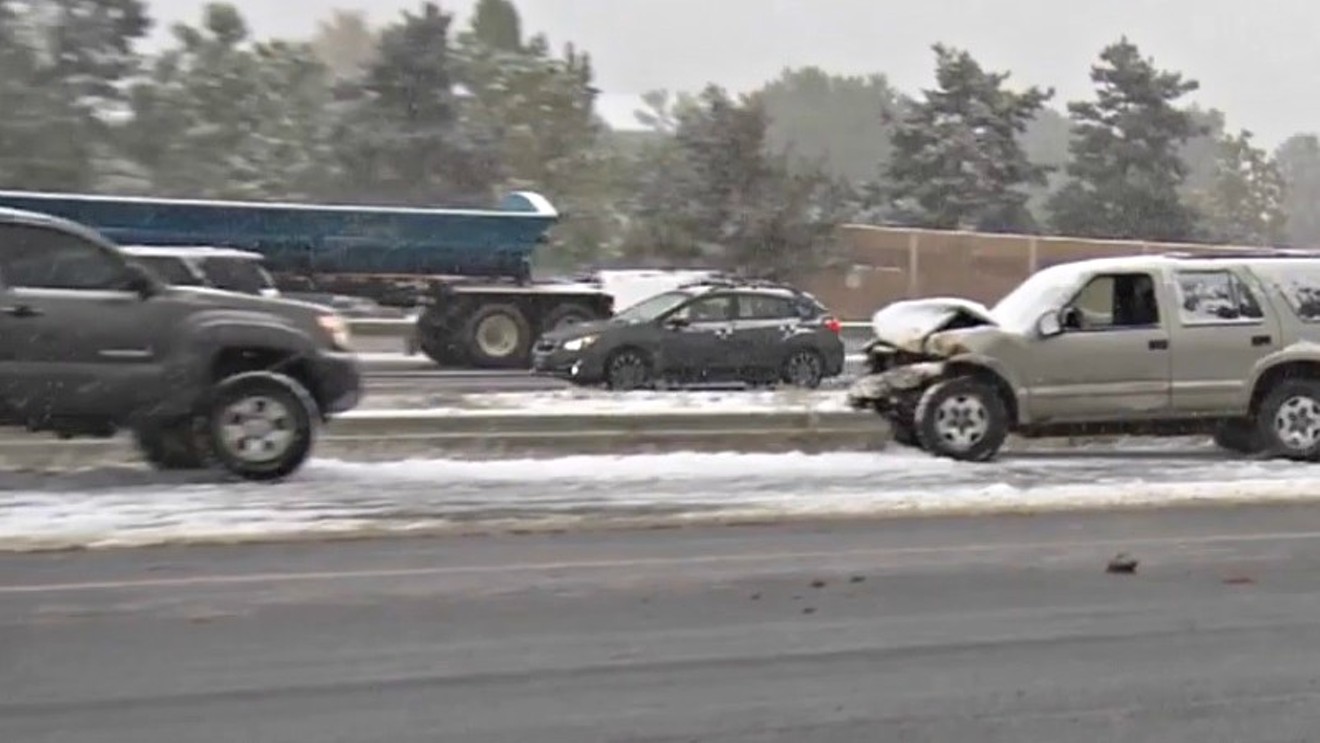And do you know who was most likely responsible for the latter, as well as any other problems related to the white-stuff dump and severe temperature plunge, according to the AAA Foundation for Traffic Safety? You.
Within minutes of the storm's first wave ebbing during the mid-afternoon, the local AAA office sent out a blast of its own. "Winter Driving: Here's What Went Wrong This AM" — issued under the auspices of AAA spokesperson Skyler McKinley, who served as deputy director of Colorado's Office of Marijuana for the administration of former governor John Hickenlooper — cites National Highway Traffic Safety Administration data estimating that "nearly 95 percent of all crashes are the result of driver error" before offering up a list of sample comments from folks who had problems during the storm, followed by responses intended to deliver the cold, hard truth.
In each and every case, the blame for what happened is placed squarely on the person doing the bitching.
Such conclusions may seem harsh to those whose ride wound up crumpled and immobile on the side of the road. But the advice is definitely worth keeping in mind the next time conditions turn ugly, as they're absolutely guaranteed to do multiple times over the course of the next few months.
Continue for AAA's tough love, reproduced verbatim.
"My car wouldn't start."
Dead batteries are the single most common call for emergency assistance to AAA Colorado. Why? Physics: As the temperature drops, so does the cranking power of your battery. At 32 degrees, your battery has 15 percent less starting power than it does at 80 degrees. At 0 degrees, it has 45 percent less power. At -20 degrees, it has less than half the cranking power — while your engine needs 3.5 times more power to start. While it didn't quite get that cold, the fact remains that winter is very tough on your battery, especially after a long, hard summer. If your battery didn't start this morning, and it is more than 3-5 years old, you should start thinking about replacing it before cold temperatures are a daily occurrence. Make sure terminals are tight and clean. If lights seem dim or vehicle starts are sluggish, have the electrical system, including battery, checked by a technician

An unpleasant moment on Denver streets yesterday.
CBS4 via YouTube
This is many motorists' first warning sign that cold temperatures are coming. Why? As the average temperature drops, so will tire pressures — typically by 1 PSI for every 10 degrees Fahrenheit. The tire pressure recommended by your car's manufacturer, typically found in your owner's manual, on the door jamb, and configured within your warning light system, is for cold tires that have been sitting for a while before you fill them up. If you last filled up to that maximum when it was hot out, or after you had been driving for a while, your pressure likely fell well below that level when temperatures began to cool. Fill up your tires on a cold morning, at least 3 hours after you last drove, to make sure that light won't come on — and that you have a safe amount of pressure to negotiate winter conditions.
"I was sliding all over the place."
It's no secret that Colorado gets heavy winters. If you drive regularly, you should absolutely consider swapping out your all-season tires with snow tires, or all-seasons with a mud and snow (M+S) designation. The proper tread can help you achieve traction, and the easiest way to have the right tread is to have the right tires for Colorado. Of course, the best tires in the world won't be much use if you've worn down all of their tread. Tires begin to lose their resistance to wet and wintry conditions with as much as 4/32 of tread remaining. How do you know if you have enough tread? Try the quarter test. If your tires don't pass that test, it's time for new tires.
"I couldn't see anything."
When was the last time you replaced your wiper blades? In Colorado, you should be in the habit of replacing them every six months or so. You definitely need new blades if you notice streaking across the whole windshield, sections of streaking, wipers that skip across the glass, or wipers that are excessively squeaky. They aren't an expensive purchase and are something you can install yourself in just a few minutes. Make sure to defrost and scrape ice and snow off your windshield before using wipers, and clean any ice off your blades before you begin your drive. When you arrive at your destination, remember to pull the windshield wipers away from the windshield to prevent refreezing. Top off your wiper fluid and make sure it is rated for low temperatures, otherwise it will freeze, and it won't do you much good, whatsoever. Under Colorado law, you must also completely clear snow and ice off your vehicle — including your roof — before driving.
"My brakes made a weird noise and the pedal started vibrating against my foot."
If your car has an anti-lock braking system, which it likely does, this means the system is working. Do not remove your foot from the brake during a skid, When you apply the brakes hard enough to make the wheels lock momentarily, you will typically feel the brake pedal vibrate and pulsate back against your foot. This is normal! Do not release pressure on the pedal or attempt to pump the brakes.
"I lost control of my vehicle and caused a crash."
Speed is the number-one factor driving winter crashes. Accelerate, turn, and brake gradually. Adjust your speed to the road conditions and leave yourself ample room to stop. You should allow at least three times more space than usual between you and the car in front of you. Normal following distances of three to four seconds on dry pavement should be extended to a minimum of eight to ten seconds when driving on slippery surfaces. In the event that you do lose control, ease off the accelerator and steer in the direction you want the front of the car to go.
"I drive an SUV with 4WD and still lost control."
You should remember that Four Wheel Drive does not mean Four Wheel Stop. While having the right equipment might allow you to better power through some conditions, it does not provide any additional braking power. Your car won't stop any faster than other cars just because it is bigger, either. In fact, a taller center of gravity may just increase stopping distances. Four-wheel or all-wheel drive will increase your traction when you're trying to get moving, which means you might end up going too fast for road conditions. That makes it that much harder to try to stop.












